The ROTC program has many requirements, procedures, and goals that it requires its cadets to meet during college. But there is also an entire culture, ethos, and atmosphere that surrounds life in the program that is just as important to understand. You may be wondering what ranks are attained throughout the program or what certain symbols mean and their history. What exactly are ROTC traditions?
The ROTC program in college is filled with both ethical and philosophical creeds and disciplines in addition to many established traditions. Cadets will commit to a creed and honor code that comprises the core values of the program, as well as experience enriching and distinctive cultural activities.
Are you wondering more about the various ROTC traditions? Are you curious about what certain symbols or sayings mean? If so, this comprehensive and in-depth guide is for you. We will explore every facet of ROTC traditions and culture to give you a better understanding of what a true ROTC experience is like during your college career. Read on to find out more about ROTC traditions and culture.
Common ROTC Traditions
The ROTC program is separate and distinct from the branch of the Armed Forces that cadets aspire to join. But the essential traditions, preparation activities, and overall culture of the ROTC program are designed to prepare cadets for life in the Armed Forces, which is something that entry-level recruits do not get to experience.
But even though the ROTC program is essentially an advanced head start for life in the Armed Forces, it is also a distinctive experience all on its own and not just a crash course for a chosen branch. There are reasons behind the discipline, honor, code, chain of command, creed, and core values of the program. In this section, we will look at each of these traditions and explain the essential role that each has in ROTC.
Military Courtesy and Discipline
Military courtesy and discipline are the entire fabric of any branch of the Armed Forces. These requirements of both courtesy and discipline are also represented in the ROTC program. Many people think that discipline is nothing more than the enforcement of regulations and the corresponding punishment when one violates them.
Others associate discipline with the state of subservience where subordinates blindly follow the orders of their superiors out of habit or fear. Neither of these definitions truly captures what discipline is meant to accomplish in the ROTC program, although it is certainly true that both of these popular concepts are in some ways true.
Both courtesy and discipline lead to the wider moral development of what it means to be a soldier in the Armed Forces.
The US Military in general that offers these types of advanced training as seen in an ROTC program has one primary goal: to guide the moral development of the individual towards ideals that are consistent with the goals of the institution through consistent maneuvers to instill courtesy and discipline to the point that it becomes second nature.
To put this level of courtesy and discipline into perspective, in terms of the ROTC program exclusively, the day-to-day operations of a non-ROTC affiliated college student may not necessarily be too different from his or her ROTC counterparts. Such a student may opt to wake up early and work out.
He or she may also engage in forms of moral studying (for example, enrolling in a course that teaches values and ethics), and may occupy positions of junior or senior leadership in organizations with which they are affiliated, such as in student organizations.
Such students are unlikely to wear uniforms, but then again they may have an affiliation with an entity where uniforms are required such as for their work on campus or for a sports team. What can be stated as a certainty is that they will not engage in battalion activities in the same fashion as an ROTC cadet, nor will they take the leadership and management class or the navigation class, so on and so forth.
This is an important distinction from the standpoint of evaluating the combined efficacy of classroom instruction and external guided instruction. An ROTC cadet is taught proper courtesy manners and etiquette that is required when interacting with superiors but is also expected during a cadet’s day-to-day life outside of the program.
Discipline is seen in pledges that cadets and later soldiers take that a cadet will never give up, never take the easy route, always show their superiors and elders respect, and always commit to bravery and stoicism. It is certainly all about dictates for life in the Armed Forces, but honestly, courtesy and discipline are also traits taught in ROTC that are meant to be carried through an entire cadet’s life, even long after service has ended.
ROTC Honor Code
Courtesy and discipline in ROTC are learned and carefully integrated moral foundations that develop over time. But when it comes to actual pledges and various codes and creeds, the ROTC has an honor code that allows no compromise.
The established honor code for each branch seen in the ROTC program states that a cadet “will not lie, cheat, steal, or tolerate those who do.”
Let’s take a look at each dictation in the honor code.
Lying is an action that nearly all of us have either advertently or inadvertently found ourselves doing at some point in our lives. Rather innocently or maliciously, deception is quite possibly the most prevalent and damaging negative trait in a person’s moral compass. Small lies could be done to prevent pain to a person or even to incite humor, and many of us can easily overlook those, but clear and present lying to maliciously deceive damages a person’s integrity.
Lies of any kind are not tolerated in the United States Armed Forces. Lying is seen as a form of weakness and a dereliction of a cadet or soldier’s value as a human being. To lie is to assault the entire moral fabric of the ROTC honor code, that despite whatever faults may be gathered about military actions either currently or in the past, is seen as a stain on the principles of courtesy, discipline, and honor instilled in military ethics.
Cheating is also frowned upon in an ROTC program. When a cadet cheats, be it on academic work or even physical training, such a cadet is seen as bypassing the discipline ethics of the military. The ROTC program wants to instill perseverance in cadets, which means that no matter how hard something is, soldiering through it builds confidence, character, and efficiency in a person.
Stealing is also frowned upon and is strictly not tolerated. Much like in regular life, the ROTC program wants to train cadets to earn what it is they are seeking and what can benefit them.
The ROTC program and that is to say, the military as a whole also expects honesty and virtue in cadets. If a cadet ever witnesses a fellow cadet engaging in any of these behaviors, the cadet is expected to report the actions to the Chain of Command. Not doing what is right is seen as a form of weakness or an inability to face confrontation or adversity. In short, you are required to report such actions that you see or hear.
All of these dictates translate to the honorability of a cadet both in the program and throughout life. If a cadet is suspected or reported of any of these actions, an investigation and a hearing will be conducted by the ROTC Chain of Command. If found guilty, a cadet is almost always removed from the program and will have to repay scholarship funds and possibly still serve their post-college service commitment.
Any of these derelictions of the honor code apply to both the program itself and a cadet’s activities outside of the program.
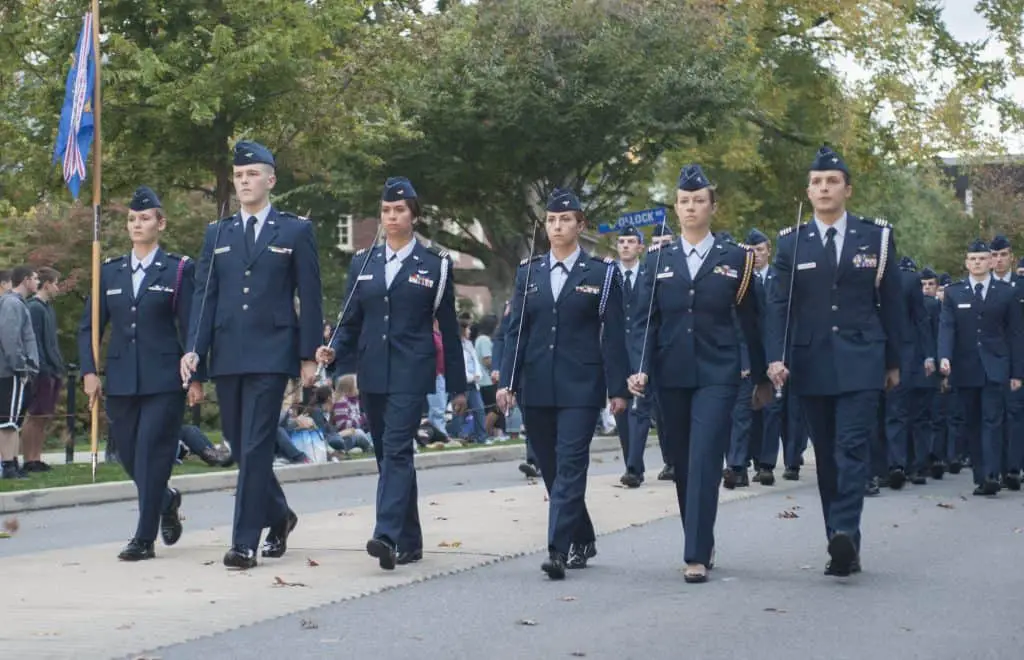
ROTC Chain of Command
Each branch of the ROTC has what is known as a cadet Chain of Command. These individuals are responsible for planning, implementing, and coordinating all cadet activities and are also the senior and immediate leaders over cadets.
The composition of the cadet Chain of Command exercises the same function across each branch but there are some differences found in each branch cadet Chain of Command.
For example, Army ROTC’s cadet Chain of Command is divided into four units: battalion, company, platoon, and squad. The Battalion Commander is responsible for everything that goes on throughout the cadet battalion. The commander supervises the efficient functioning of the staff and subordinate commanders to ensure that missions assigned to the cadet battalion are performed in a professional manner.
This is accomplished by issuing guidance and monitoring the execution of assigned tasks. The commander also conducts weekly cadet staff meetings to determine progress on projects, updates the staff with any new guidance, briefs the Professor of Military Science on the progress of cadet functions, and reports on the status of projects at least weekly.
Each additional unit also has a primary leader that composes the Chain of Command, and the Professor of Military Science can be viewed as the top-tier administrator within any ROTC program.
As you rise in rank throughout the ROTC program, you could possibly be tapped on the shoulder and asked to join the Chain of Command. It all depends on your overall performance and the various assessments and reports that Chain of Command gathers and presents to the Professor of Military Science.
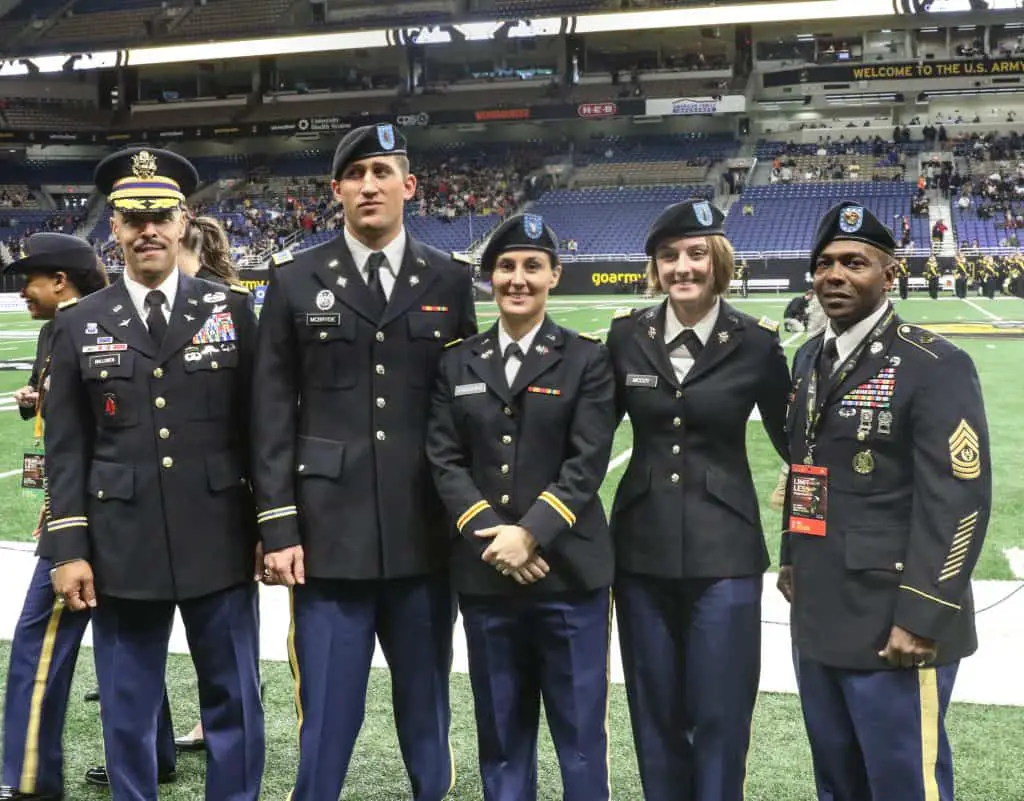
ROTC Creed
Each branch of the ROTC program has a creed that establishes the identity of the cadet and the mission statement the cadet is expected to fulfill and live by.
These creeds contain context that establishes the honor code, courtesy, discipline, and mission of each cadet as it corresponds to the language and scope of activity of each branch.
The Army ROTC creed states:
“I am an Army Cadet. Soon I will take an oath and become an Army Officer committed to defending the values which make this nation great. Honor is my touchstone. I understand the mission first and people always. I am the past – the spirit of those warriors who have made the final sacrifice. I am the present – the scholar and apprentice Soldier enhancing my skills in the science of warfare and the art of leadership. But above all, I am the future – the future warrior leader of the United States Army. May God give me the compassion and judgment to lead and the gallantry in battle to win.”
The creeds for the Navy and Air Force ROTC programs respectively are similar in terms of a pledge to the honor code and the future service commitment of the cadet. The wording is different to match the maritime pursuits of the Navy and the aerial pursuits of the Air Force respectively.
In each creed, you are committing to the defense of the U.S. Constitution, your pledge to the service requirement of any soldier in the U.S. Armed Forces, and verbally stating the pledges to live by honor, bravery, and virtue.
ROTC Core Values
No matter what branch of the ROTC program you commit to, there will be a similar set of core values that are meant to be the defining principles of your time in the program and throughout your future service in the U.S. Armed Forces.
The first core value is a commitment to loyalty. Loyalty can mean many different things; it can mean a commitment to remain loyal to the ROTC program and to your service commitment post-college, a commitment to remain loyal to your superiors, and of course, a commitment to remain loyal to the United States of America. It also means a commitment to be loyal to your unit, fellow cadets/soldiers, and to your specific branch of the Armed Forces.
Duty is also an important core value. The core value of duty is very important since you will always be required to meet your commitments no matter how hard or how menial.
The ROTC program is filled with required duties, and a cadet will be expected to meet their duties satisfactorily while also maintaining the other key core values in each duty that is fulfilled.
An ROTC cadet is expected to remain respectful and to show respect at all times where it is due and where it is required. Treat others as they should be treated and never resort to malice or arrogance to any person. Always address superiors in the proper way and maintain strict adherence to protocols as defined by these circumstances.
Courage is also a key core value in the ROTC program. A cadet and later a soldier is expected to show selfless service and personal courage in terms of the nation, the branch, the unit, and any subordinates or civilians in terms of their personal welfare. Cowardice or lack of bravery is not tolerated in any ROTC branch.
Finally, honor and integrity are core values that we have already touched upon. A cadet will demonstrate honor at all times and always strive to commit to stellar personal integrity by doing what is right and just and never demonstrating deception or lack of moral judgment.
A cadet should always be prepared to face fear, adversity, and danger with a selfless degree of courage and duty.
ROTC Symbols
Now that we have covered the most important aspects of ROTC traditions, let’s take a look at some of the more intriguing symbols in the ROTC program and what each symbol means and represents.
ROTC Flag
Each branch of the ROTC program has a corresponding flag that contains unique symbols, patterns, and fabric that highlight the program as well as the branch of the Armed Forces that it corresponds to.
The Army ROTC flag highlights the words leadership and excellence across a crest representing battle. The Navy ROTC flag displays maritime crests and symbols while the Air Force ROTC flag displays aerial crests and symbols that correspond to America’s aviation history in terms of combat.
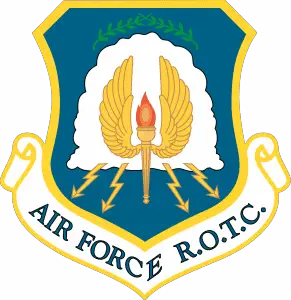
ROTC Crest
Each branch also has a unique crest that dates back to the origins of the specific branch represented. For example, the Army ROTC crest symbolizes the Army’s mission of national defense and is divided into quarters representing the four traditional military science courses compromising the senior ROTC curriculum. The sword signifies the courage, gallantry, and self-sacrifice intrinsic to the profession of arms.
The lamp denotes the pursuit of knowledge, higher learning, and the partnership of Army ROTC with American colleges and universities. The Greek helmet is symbolic of the ancient civilization concept of the warrior-scholar. The motto “Leadership Excellence” expresses the ultimate responsibility of Army ROTC in the discharge of its moral responsibility to the Nation.
The Navy ROTC crest features the crest of the United States surrounded by an anchor to signify the maritime pursuits of the U.S. Navy.
The Air Force ROTC crest shows a set of golden wings hovering over a burning flame which symbolizes flight and combat.
ROTC Saber
Each branch of the ROTC features a saber (sword) in its regalia and ceremonial insignia. The saber is worn by officers while participating in ceremonies with troops under arms, or as directed. It is worn on the left side of the body attached to the belt by the scabbard chain with the guard of the saber to the rear. The sword is worn mostly during ceremonies and only awarded to cadets of superior performance and rank.
ROTC Color Guard
Each branch also has what is known as a color guard. The Color Guard is a group of four cadets that present the United States and branch-specific flags at games and ceremonies. Presenting the “Colors” is a military tradition dating back to the beginning of our country. When performing a Color Guard, these four cadets form a line.
The cadets on the end carry rifles, while the middle-right cadet carries the US flag and the middle-right carries the ROTC branch flag. Before the event, they present their flags and rifles. After the event, the Color Guard ensures the proper retirement of the Colors.
The Color Guard is a cornerstone of the ROTC ceremony.
ROTC Rankings
Each branch of the ROTC program ensures that cadets who graduate and successfully complete the program will enter the Armed Forces as second-lieutenant. But there are still ranking systems throughout the advanced portion of the ROTC program. Let’s take a look at each specific branch’s ranking progression.
Army ROTC Cadet Ranks
Military ranks identify who is in charge, indicate levels of leadership and responsibility, and support fast and effective decision-making and problem-solving. The Continental Army drew its rank structure—lieutenant, captain, major, colonel, and general—from the traditions of Great Britain, and today’s structure remains close to that of the Continental Army.
For example, Lieutenants and captains are “company grade” officers, majors and colonels are “field grade” officers, and generals are “flag” officers. Army ROTC new freshmen (MS I) enter the program at the rank of Cadet Private (C/PVT) and rarely hold leadership positions. Sophomores (MS II) hold the rank of Cadet Corporal (C/CPL), but like the C/PVTs, they hold few leadership positions throughout the year.
Juniors (MS III) hold the rank of Cadet Staff Sergeant (C/SSG) and are the first-level leaders for the freshmen and sophomores. Each MS III rotates through the squad leader (SL), platoon sergeant (PSG), platoon leader (PL), First Sergeant (1SG), and Company Commander positions throughout the course of the year under the supervision and direction of the Seniors (MS IV).
While in these positions, the MS III’s will teach basic battle drills, land navigation, and other technical and tactical skills to the underclassmen while honing their own leadership skills.
Air Force ROTC Ranks
Air Force ROTC has a bit of a more complex ranking structure and primarily consists of categories that classify cadets into the following basic categories of training with respect to Field Training (FT) attendance and commissioning:
- Initial Military Training (IMT): Cadets who are part of the GMC (general military course) but are not scheduled to attend FT the following summer.
- Field Training Preparation (FTP): Cadets scheduled to attend FT in the upcoming summer.
- Intermediate Cadet Leader (ICL): Cadets who have successfully completed FT but are not scheduled to commission in the upcoming year.
- Senior Cadet Leader (SCL): Cadets who have satisfactorily completed FT and are scheduled to be commissioned in the upcoming year.
- Extended Cadet Leader (ECL): Cadets who have completed the AFROTC curriculum but need additional time to complete their academic degree, such as 5-year engineering program students.
This structure is broken down as detachments that organize cadets after the active-duty wing structure to the best of their ability, compensating for variable sizes and circumstances. GMC cadets participate as the underclassmen while the POC cadets participate as the upperclassmen. POC cadets have completed Field Training and are assigned leadership positions in the corps.
Additionally, cadets are classified and assigned ranks commensurate with their position and level of responsibility within the cadet wing and with respect to FT completion.
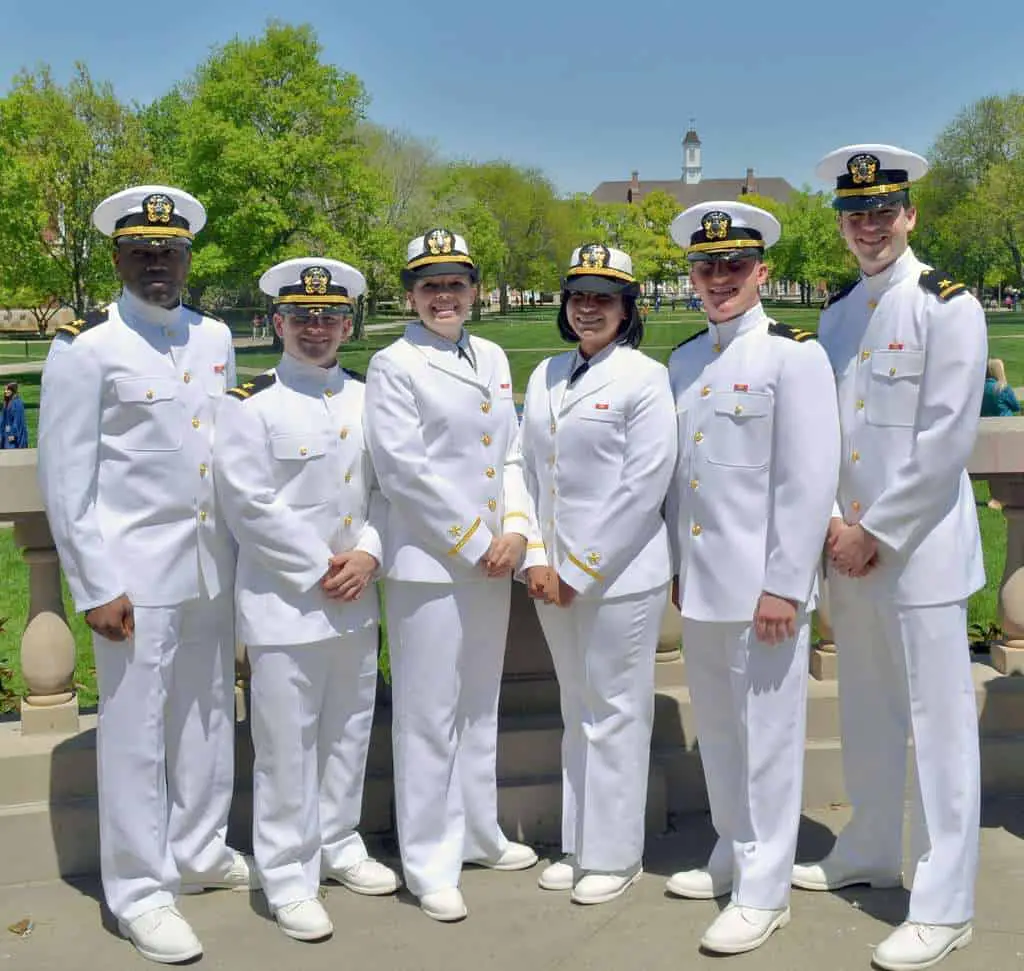
Navy ROTC Ranks
Upon successful completion of the Navy ROTC program, successful cadets will enter the United States Navy with the rank of Ensign. The rankings from the beginning of the program to Ensign are as follows:
- Seaman Recruit
- Seaman Apprentice
- Seaman
- Petty Officer Third Class
- Petty Officer Second Class
- Petty Officer First Class
- Chief Petty Officer
- Senior Chief Petty Officer
- Master Chief Petty Officer
- Master Chief Petty Officer of the Navy
A Navy ROTC cadet will elevate through all of these rankings before graduation from the program.
ROTC Dining Traditions
During the day-to-day of the ROTC program, cadets will dine as normal college students according to their own preferences. This differs greatly from the rigid set of rules that accompany basic training for entry-level recruits.
But each branch of the ROTC program features many different unique ceremonies and rituals that all revolve around fellowship and camaraderie through meals.
Let’s take a look at some of the most significant dining traditions in the ROTC program.
ROTC Dining Out
In Air Force ROTC, there is a tradition known as dining out. This tradition dates back to the World War II era and is a formal dinner at a designated space in which cadets are permitted to bring guests along to the dinner with them.
This is a simple occasion where fellow cadets can get to know each other and a cadet’s friends and family a lot better due to the strict dictates of duty that come with the program.
Dining Out usually takes place at the end of a semester, and although the event is formal, and procedures and military customs are still enforced, the event is a largely entertaining affair.
One aspect of Dining Out that is both entertaining and horrifying all at the same time is a tradition known as “the grog.” The Grog Bowl tradition is found in all branches of the military and corresponding ROTC programs.
The grog is basically two toilet bowls that are filled with unpleasant mixtures of food and drink. The contents of the bowls are decided by the senior cadets and are meant to be disgusting. Cadets must drink from the grog if they violate any rules of etiquette at the dinner, such as not rising from their chair if a woman stands or if they violate protocol or the dress code stated for the formal dinner.
Also, certain cadets will occasionally stand during the dinner to recite certain rhymes that must be completed by a cadet they call upon. If the called upon cadet cannot finish the rhyme, they must drink from the grog. The tradition is largely meant for humor and is considered an ROTC rite of passage.
ROTC Grog Bowl Recipe
If you are interested, the recipe for a Grog Bowl usually consists of food and drink items that normally would not be palatable. For example, a standard Grog Bowl will consist of items such as corn flakes, oatmeal, orange juice, Gatorade, soda, yogurt, pickles, onions, garlic, milk, and virtually any edible ingredient that when combined with others will churn the stomach.
The Grog ceremony for ROTC usually omits liquor or other alcoholic beverages, but the ceremony has been known to include these items during senior semesters.
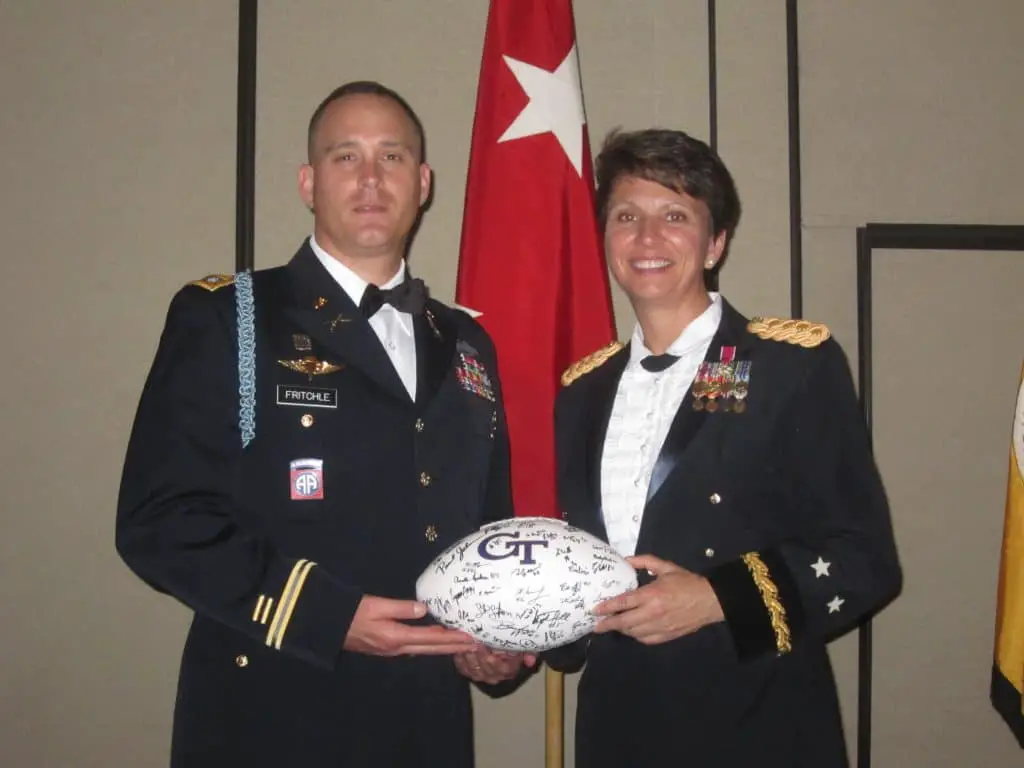
ROTC Formal Dinner
Formal dinners can also occur randomly as set out by various chains of command. A formal dinner is for camaraderie and celebration, but strict protocols are enforced and expected, especially if senior ranking members of a branch are in attendance at a formal dinner. These traditions are also known as “dining-in.”
As a cadet or junior officer, you are charged with the responsibility of assuring the survival of the long-standing traditions and customs associated with the dining-in. Unlike the regiments of a Branch, cadet companies have no collective battle heritage, however, the contributions of former cadets to the leadership of American soldiers in battle is a defining theme of an ROTC formal dinner.
This theme of past accomplishments and potential for future contributions should form the unifying theme of a cadet dining in.
ROTC Culture
In addition to all of the main points we have discussed, there is a distinctive culture attached to ROTC that can be found in everything from tones of voice to sayings, cadences, and even songs. Cadences and command voice are by far two of the most important aspects to keep in mind as these traditions will largely be expected through self-learning.
Additionally, there are various special awards that are given out throughout a cadet’s tenure in an ROTC program, with the Superior Cadet Award being one of the most prominent.
Let’s take a look at some of these cultural features and explore each in detail for a better understanding of how each of these unique cultural traditions plays such a large role in what it is like to be in an ROTC program.
ROTC Command Voice
In each ROTC branch, you will be required to speak with urgency and forcefulness in each command that you give or question you respond to. A correctly delivered command will be understood by everyone in the unit. Correct commands have a tone, cadence, and snap that demand a willing, correct, and immediate response.
The loudness of command is adjusted to the number of cadets in the unit. Normally, the commander is to the front and center of the unit and speaks facing the unit so that his voice reaches everyone. The voice must carry power, but excessive exertion is unnecessary and harmful. A typical result of trying too hard is the almost unconscious tightening of the neck muscles to force the sound out.
This produces strain, hoarseness, sore throat, and worst of all, indistinct and jumbled sounds instead of clear commands. Ease is achieved through good posture, proper breathing, correct adjustment of throat and mouth muscles, and confidence.
You may find that the best posture for giving commands is the position of attention. Cadets in formation notice the posture of their leader. If his/her posture is unmilitary (relaxed, slouched, stiff, or uneasy), this can lead to imitation from the unit. The most important muscle used in breathing is the diaphragm, which is the large muscle that separates the chest cavity from the abdominal cavity.
The diaphragm automatically controls normal breathing and is used to control the breath in giving commands. The throat, mouth, and nose act as amplifiers and help to give fullness (resonance) and projection to the voice. Distinct commands are effective; indistinct commands cause confusion. All commands can be pronounced correctly without loss of effect.
In an ROTC program, command voice will be taught, but it will require lots of practice to get the command voice just right.
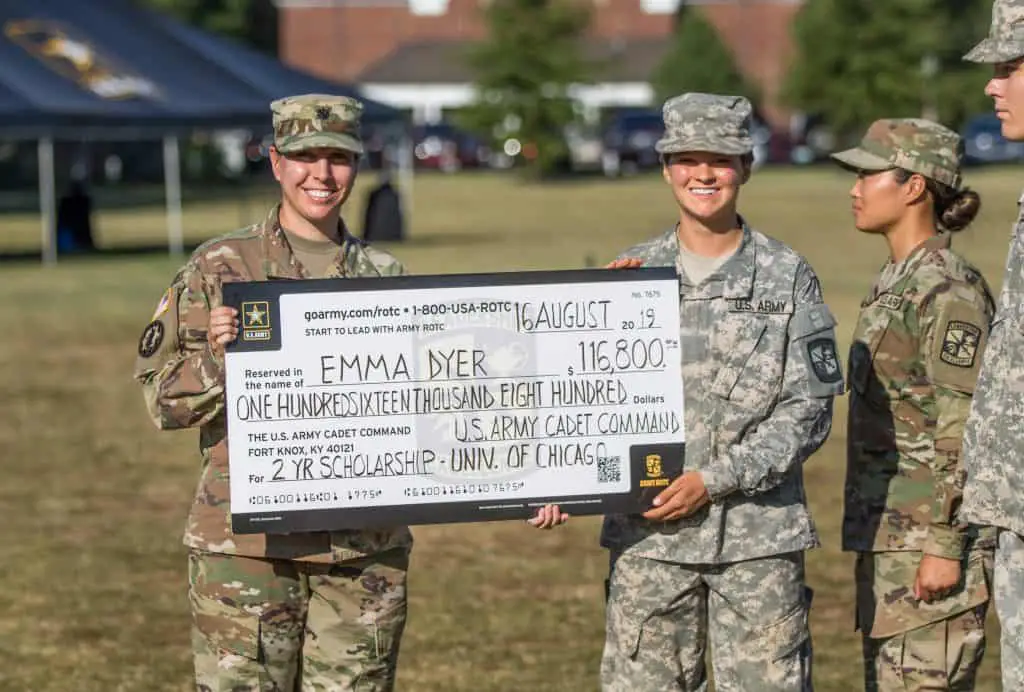
ROTC Superior Cadet Award
The Superior Cadet Award is the second-highest award within the sphere of the Department of the Army. It is also exclusively reserved for ROTC cadets.
This award is presented annually to the most outstanding cadet in a respective unit. To be considered for the award, you must expect to meet criteria relating to superior academic performance, obvious and proven office rank potential, and you must be in the top 25% of your university’s overall ROTC rankings according to Chains of Command and the Professor of Military Science.
The award is competitive as the judging will come down to the one cadet who has the highest rankings in each of the criteria fields.
ROTC Sayings
Discipline is seen in pledges that cadets and later soldiers take that a cadet will never give up, never take the easy route, always show their superiors and elders respect, and always commit to bravery and stoicism. It is certainly all about dictates for life in the Armed Forces, but honestly, courtesy and discipline are also traits taught in ROTC that are meant to be carried through an entire cadet’s life, even long after service has ended.
This can be found in many different sayings corresponding to each branch of the ROTC program. Army ROTC uses the words leadership and excellence as their motto. This is meant to imply that if you only take two essential themes away from your time in ROTC and the Armed Forces, being a leader and always achieving excellence in every task that you do should be the defining sayings that are attached to Army ROTC.
Navy ROTC also features many different sayings with the Sailor’s Creed being the most prominent. The Creed states,
“I am a United States Sailor. I will support and defend the Constitution of the United States of America and I will obey the orders of those appointed over me. I represent the fighting spirit of the Navy and those who have gone before me to defend freedom and democracy around the world. I proudly serve my country’s Navy combat team with Honor, Courage, and Commitment. I am committed to excellence and the fair treatment of all.”
No matter which branch you choose, there are many sayings in ROTC that you will become familiar with, and many that you will also be expected to memorize.
ROTC Songs
Each branch of ROTC also has corresponding songs that feature unique references to the focus and goal of a specific branch as well as lyrics that highlight the commitment to honor, duty, and excellence that is expected from any cadet/soldier in the United States Armed Forces.
For example, Army ROTC has two common songs that cadets will be expected to learn and are typically performed during drills and PT.
ROTC Cadences
Cadences are words and rhythmic sayings that are used corresponding to a particular activity in a drill or physical training exercise. Each branch of ROTC has its own distinctive cadences, and the goal of each cadence is to time your body movements and formation with fellow cadets during the exercise with the perfect symmetry of speaking the words.
Army ROTC has several cadences that cadets will learn as time goes on and training and drills increase. Additionally, Army ROTC Jodies and Air Force ROTC Jodies are also cadences but are simply called something else. There is practically no difference between a cadence and a Jodie with the exception that Jodies are typically a lot shorter on words.
Cadences are also shown to improve a cadet’s posture, increase mastery of breathing during intense physical exertion, and also increase energy output during the exercise due to the mastery of complex breathing patterns.
Summary
As you can see, there are numerous traditions that are embedded into the culture of the ROTC program. All of these cultural traditions correspond directly to the branch of the Armed Forces in which a cadet will be joining once they successfully graduate from the program.
The most important traditions to keep in mind are the integral codes of honor that define every facet of the Armed Forces. Keep these traditions in mind when considering applying for an ROTC program and you will enter the program with a firm foundation of knowledge of what you can expect throughout.
